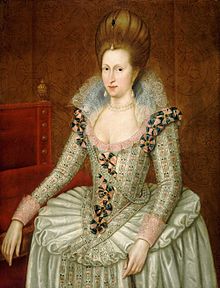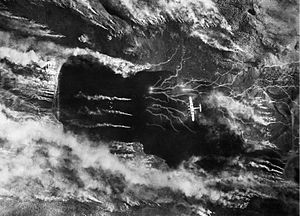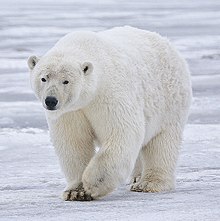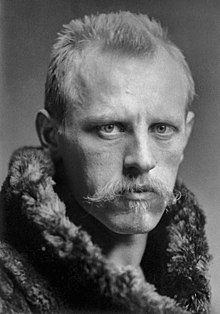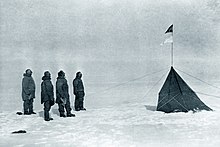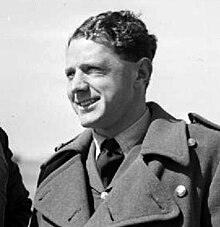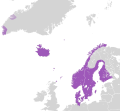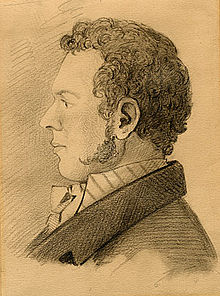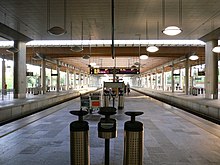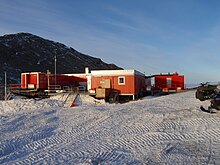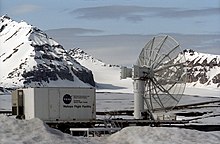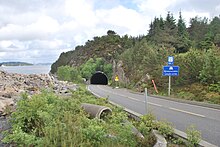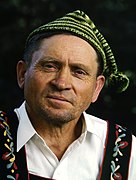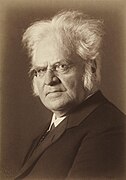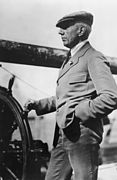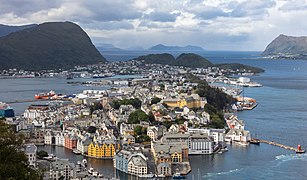Portal:Norway
The Norway Portal
Norge Portal

|

|

| |
Norway, officially the Kingdom of Norway, is a Nordic country in Northern Europe, situated on the Scandinavian Peninsula, with a population of 5.5 million as of 2024. The remote Arctic island of Jan Mayen and the archipelago of Svalbard also form part of the Kingdom of Norway. Bouvet Island, located in the Subantarctic, is a dependency, and not a part of the Kingdom; Norway also claims the Antarctic territories of Peter I Island and Queen Maud Land. The capital and largest city in Norway is Oslo.
Norway has a total area of 385,207 square kilometres (148,729 sq mi). The country shares a long eastern border with Sweden, and is bordered by Finland and Russia to the northeast. Norway has an extensive coastline facing the Skagerrak strait, the North Atlantic Ocean, and the Barents Sea.
Harald V of the House of Glücksburg is the current King of Norway. Jonas Gahr Støre has been Prime Minister of Norway since 2021. As a unitary state with a constitutional monarchy, Norway divides state power between the parliament, the cabinet, and the supreme court, as determined by the 1814 constitution. Norway has both administrative and political subdivisions on two levels: counties and municipalities. The Sámi people have a certain amount of self-determination and influence over traditional territories through the Sámi Parliament and the Finnmark Act. Norway maintains close ties with the European Union and the United States. Norway is a founding member of the United Nations, NATO, the European Free Trade Association, the Council of Europe, the Antarctic Treaty, and the Nordic Council; a member of the European Economic Area, the WTO, and the OECD; and a part of the Schengen Area. The Norwegian dialects share mutual intelligibility with Danish and Swedish. (Full article...)
-
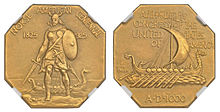
The Norse-American medal was struck at the Philadelphia Mint in 1925, pursuant to an act of the United States Congress. It was issued for the 100th anniversary of the voyage of the ship Restauration, bringing early Norwegian immigrants to the United States.
U.S. Representative from Minnesota Ole Juulson Kvale, a Norwegian American, wanted a commemorative for the centennial celebrations of the Restauration journey. Rebuffed by the Treasury Department when he sought the issuance of a special coin, he instead settled for a medal. Sculpted by Buffalo nickel designer James Earle Fraser, the medals recognize those immigrants' Viking heritage, depicting a warrior of that culture on the obverse and his vessel on the reverse. The medals also recall the early Viking explorations of North America. (Full article...) -
Anne of Denmark (Danish: Anna; 12 December 1574 – 2 March 1619) was the wife of King James VI and I. She was Queen of Scotland from their marriage on 20 August 1589 and Queen of England and Ireland from the union of the Scottish and English crowns on 24 March 1603 until her death in 1619.
The second daughter of King Frederick II of Denmark and Sophie of Mecklenburg-Güstrow, Anne married James at age 14. They had three children who survived infancy: Henry Frederick, Prince of Wales, who predeceased his parents; Princess Elizabeth, who became Queen of Bohemia; and James's future successor, Charles I. Anne demonstrated an independent streak and a willingness to use factional Scottish politics in her conflicts with James over the custody of Prince Henry and his treatment of her friend Beatrix Ruthven. Anne appears to have loved James at first, but the couple gradually drifted and eventually lived apart, though mutual respect and a degree of affection survived. (Full article...) -
In September 1967, Denmark, Norway, Sweden and the Netherlands brought the Greek case to the European Commission of Human Rights, alleging violations of the European Convention of Human Rights (ECHR) by the Greek junta, which had taken power earlier that year. In 1969, the Commission found serious violations, including torture; the junta reacted by withdrawing from the Council of Europe. The case received significant press coverage and was "one of the most famous cases in the Convention's history", according to legal scholar Ed Bates.
On 21 April 1967, right-wing army officers staged a military coup that ousted the Greek government and used mass arrests, purges and censorship to suppress their opposition. These tactics soon became the target of criticism in the Parliamentary Assembly of the Council of Europe, but Greece claimed they were necessary as a response to alleged Communist subversion and justified under Article 15 of the ECHR. In September 1967, Denmark, Norway, Sweden, and the Netherlands filed identical cases against Greece alleging violations of most of the articles in the ECHR that protect individual rights. The case was declared admissible in January 1968; a second case filed by Denmark, Norway and Sweden for additional violations, especially of Article 3 forbidding torture, was declared admissible in May of that year. (Full article...) -
On 9 February 1945, a force of Allied Bristol Beaufighter aircraft suffered many losses during an attack on the German destroyer Z33 and its escorting vessels; the operation was called Black Friday by the survivors. The German ships were sheltering in a strong defensive position in Førde Fjord, Norway, forcing the Allied aircraft to attack through massed anti-aircraft fire (FlaK).
The Beaufighters and their escort of Mustang Mk III fighters from 65 Squadron RAF were intercepted by twelve Focke-Wulf Fw 190s of Jagdgeschwader 5 (Fighter Wing 5) of the Luftwaffe. The Allies damaged at least two of the German ships for the loss of seven Beaufighters shot down by FlaK. Two Beaufighters and a Mustang were shot down by the Fw 190s and four or five of the German aircraft were shot down by the Allied aircraft, including that of the ace Rudi Linz. (Full article...) -
Operation Mascot was an unsuccessful British carrier air raid conducted against the German battleship Tirpitz at her anchorage in Kaafjord, Norway, on 17 July 1944. The attack was one of a series of strikes against the battleship launched from aircraft carriers between April and August 1944, and was initiated after Allied intelligence determined that the damage inflicted during the Operation Tungsten raid on 3 April had been repaired.
A force of 44 British dive bombers and 40 fighters took off from three aircraft carriers in the early hours of 17 July. German radar stations detected these aircraft while they were en route to Kaafjord, and Tirpitz was protected by a smoke screen by the time the strike force arrived. Few of the British airmen were able to spot the battleship, and their attacks did not inflict any significant damage. German losses were limited to a patrol craft, and three British aircraft were destroyed or damaged beyond repair by Kaafjord's defenders. A group of German submarines attempted to intercept the carrier force as it returned to base, without success. Two U-boats were sunk near the carriers by British patrol aircraft and several others were damaged. (Full article...) -
The 1952 Winter Olympics, officially known as the VI Olympic Winter Games (Norwegian: De 6. olympiske vinterleker; Nynorsk: Dei 6. olympiske vinterleikane) and commonly known as Oslo 1952, were a winter multi-sport event held from 14 to 25 February 1952 in Oslo, the capital of Norway.
Discussions about Oslo hosting the Winter Olympic Games began as early as 1935; the city was keen to host the 1948 Winter Olympics, but that was made impossible by World War II. Instead, Oslo won the right to host the 1952 Games in a contest that included Cortina d'Ampezzo in Italy and Lake Placid in the United States. All of the Olympic venues were in Oslo's metropolitan area, except for the alpine skiing events, which were held at Norefjell, 113 km (70 mi) from the capital. A new hotel was built for the press and dignitaries, along with three dormitories to house athletes and coaches, creating the first modern athlete's village. Oslo bore the financial burden of hosting the Games in return for the revenue they generated. The 1952 Winter Olympics was the first of the two consecutive Olympics to be held in Northern Europe, preceding the 1952 Summer Olympics in Helsinki, Finland. (Full article...) -

Fram leaves Bergen on 2 July 1893, bound for the Arctic Ocean
Nansen's Fram expedition of 1893–1896 was an attempt by the Norwegian explorer Fridtjof Nansen to reach the geographical North Pole by harnessing the natural east–west current of the Arctic Ocean. In the face of much discouragement from other polar explorers, Nansen took his ship Fram to the New Siberian Islands in the eastern Arctic Ocean, froze her into the pack ice, and waited for the drift to carry her towards the pole. Impatient with the slow speed and erratic character of the drift, after 18 months Nansen and a chosen companion, Hjalmar Johansen, left the ship with a team of Samoyed dogs and sledges and made for the pole. They did not reach it, but they achieved a record Farthest North latitude of 86°13.6′N before a long retreat over ice and water to reach safety in Franz Josef Land. Meanwhile, Fram continued to drift westward, finally emerging in the North Atlantic Ocean.
The idea for the expedition had arisen after items from the American vessel Jeannette, which had sunk off the north coast of Siberia in 1881, were discovered three years later off the south-west coast of Greenland. The wreckage had obviously been carried across the polar ocean, perhaps across the pole itself. Based on this and other debris recovered from the Greenland coast, the meteorologist Henrik Mohn developed a theory of transpolar drift, which led Nansen to believe that a specially designed ship could be frozen in the pack ice and follow the same track as Jeannette wreckage, thus reaching the vicinity of the pole. (Full article...) -
Operation Paravane was a British air raid of World War II that inflicted heavy damage on the German battleship Tirpitz, at anchor in Kaafjord in the far north of German-occupied Norway. The attack was conducted on 15 September 1944 by 21 Royal Air Force heavy bombers, which flew from an airfield in the north of the Soviet Union. The battleship was struck by one bomb, and further damaged by several near misses. This damage rendered Tirpitz unfit for combat, and she could not be repaired as it was no longer possible for the Germans to sail her to a major port.
The attack on 15 September followed a series of raids conducted against Tirpitz with limited success by Royal Navy carrier aircraft between April and August 1944, seeking to sink or disable the battleship at her anchorage, so that she no longer posed a threat to Allied convoys travelling to and from the Soviet Union. The first of these raids was successful, but the other attacks failed due to shortcomings with the Fleet Air Arm's strike aircraft and the formidable German defences. As a result, the task of attacking the battleship was transferred to the RAF's Bomber Command. Avro Lancaster bombers from the Command's two elite squadrons flew to their staging airfield in the Soviet Union on the night of 11/12 September, and attacked on 15 September using heavy bombs and air-dropped mines. All of the British aircraft returned to base, though one of the Lancasters later crashed during its flight back to the United Kingdom. (Full article...) -
Operation Tungsten was a Second World War Royal Navy air raid that targeted the German battleship Tirpitz. The operation sought to damage or destroy Tirpitz at her base in Kaafjord in the far north of Norway before she could become fully operational again following a period of repairs.
The British decision to strike Kaafjord was motivated by fears that the battleship, upon re-entering service, would attack strategically important convoys carrying supplies to the Soviet Union. Removing the threat posed by Tirpitz would also allow the Allies to redeploy the capital ships which had to be held in the North Sea to counter her. After four months of training and preparations, the British Home Fleet sailed on 30 March 1944 and aircraft launched from five aircraft carriers struck Kaafjord on 3 April. The raid achieved surprise, and the British aircraft met little opposition. Fifteen bombs hit the battleship, and strafing by fighter aircraft inflicted heavy casualties on her gun crews. Four British aircraft and nine airmen were lost during the operation. (Full article...) -
The polar bear (Ursus maritimus) is a large bear native to the Arctic and nearby areas. It is closely related to the brown bear, and the two species can interbreed. The polar bear is the largest extant species of bear and land carnivore, with adult males weighing 300–800 kg (660–1,760 lb). The species is sexually dimorphic, as adult females are much smaller. The polar bear is white- or yellowish-furred with black skin and a thick layer of fat. It is more slender than the brown bear, with a narrower skull, longer neck and lower shoulder hump. Its teeth are sharper and more adapted to cutting meat. The paws are large and allow the bear to walk on ice and paddle in the water.
Polar bears are both terrestrial and pagophilic (ice-living) and are considered marine mammals because of their dependence on marine ecosystems. They prefer the annual sea ice but live on land when the ice melts in the summer. They are mostly carnivorous and specialized for preying on seals, particularly ringed seals. Such prey is typically taken by ambush; the bear may stalk its prey on the ice or in the water, but also will stay at a breathing hole or ice edge to wait for prey to swim by. The bear primarily feeds on the seal's energy-rich blubber. Other prey include walruses, beluga whales and some terrestrial animals. Polar bears are usually solitary but can be found in groups when on land. During the breeding season, male bears guard females and defend them from rivals. Mothers give birth to cubs in maternity dens during the winter. Young stay with their mother for up to two and a half years. (Full article...) -
Fridtjof Wedel-Jarlsberg Nansen (Norwegian: [ˈfrɪ̂tːjɔf ˈnɑ̀nsn̩]; 10 October 1861 – 13 May 1930) was a Norwegian polymath and Nobel Peace Prize laureate. He gained prominence at various points in his life as an explorer, scientist, diplomat, humanitarian and co-founded the Fatherland League.
He led the team that made the first crossing of the Greenland interior in 1888, traversing the island on cross-country skis. He won international fame after reaching a record northern latitude of 86°14′ during his Fram expedition of 1893–1896. Although he retired from exploration after his return to Norway, his techniques of polar travel and his innovations in equipment and clothing influenced a generation of subsequent Arctic and Antarctic expeditions. He was elected an International Member of the American Philosophical Society in 1897. (Full article...) -
The first ever expedition to reach the Geographic South Pole was led by the Norwegian explorer Roald Amundsen. He and four other crew members made it to the geographical south pole on 14 December 1911, which would prove to be five weeks ahead of the competitive British party led by Robert Falcon Scott as part of the Terra Nova Expedition. Amundsen and his team returned safely to their base, and about a year later heard that Scott and his four companions had perished on their return journey.
Amundsen's initial plans had focused on the Arctic and the conquest of the North Pole by means of an extended drift in an icebound ship. He obtained the use of Fridtjof Nansen's polar exploration ship Fram, and undertook extensive fundraising in a country that had gained its independence only some six years earlier. Preparations for this expedition were disrupted when, in 1909, the rival American explorers Frederick Cook and Robert Peary each claimed to have reached the North Pole - both claims are highly disputed. Amundsen then changed his plan and began to prepare for a conquest of the South Pole; uncertain of the extent to which the public and his backers would support him, he kept this revised objective secret. When he set out in June 1910, he led even his crew to believe they were embarking on an Arctic drift, and revealed their true Antarctic destination only when Fram was leaving their last port of call, Madeira, on 9 September 1910. (Full article...) -
Caesar Barrand Hull, DFC (26 February 1914 – 7 September 1940) was a Royal Air Force (RAF) flying ace during the Second World War, noted especially for his part in the fighting for Narvik during the Norwegian Campaign in 1940, and for being one of "The Few"—the Allied pilots of the Battle of Britain, in which he was shot down and killed. From a farming family, Hull's early years were spent in Southern Rhodesia, South Africa and Swaziland. He boxed for South Africa at the 1934 Empire Games. After being turned down by the South African Air Force because he did not speak Afrikaans, he joined the RAF and, on becoming a pilot officer in August 1936, mustered into No. 43 Squadron at RAF Tangmere in Sussex.
A skilful pilot, Hull dedicated much of his pre-war service to aerobatics, flying Hawker Audaxes, Furies and Hurricanes. He reacted to the outbreak of war with enthusiasm and achieved No. 43 Squadron's first victory of the conflict in late January 1940. Reassigned to Norway in May 1940 to command a flight of Gloster Gladiator biplanes belonging to No. 263 Squadron, he downed four German aircraft in an hour over the Bodø area south-west of Narvik on 26 May, a feat that earned him the Distinguished Flying Cross. He was shot down the next day, and invalided back to England. Hull returned to action at the end of August, when he was made commander of No. 43 Squadron with the rank of squadron leader. A week later, he died in a dogfight over south London. (Full article...) -
Harriet Sofie Bosse (19 February 1878 – 2 November 1961) was a Swedish–Norwegian actress. A celebrity in her day, Bosse is now most commonly remembered as the third wife of the playwright August Strindberg. Bosse began her career in a minor company run by her forceful older sister Alma Fahlstrøm in Kristiania (now Oslo, the capital of Norway). Having secured an engagement at the Royal Dramatic Theatre, the main drama venue of Sweden's capital Stockholm, Bosse caught the attention of Strindberg with her intelligent acting and exotic "oriental" appearance.
After a whirlwind courtship, which unfolds in detail in Strindberg's letters and diary, Strindberg and Bosse were married in 1901, when he was 52 and she 23. Strindberg wrote a number of major roles for Bosse during their short and stormy relationship, especially in 1900–01, a period of great creativity and productivity for him. Like his previous two marriages, the relationship failed as a result of Strindberg's jealousy, which some biographers have characterized as paranoid. (Full article...) -
"Don't Say You Love Me" is the debut single of M2M, a Norwegian pop duo consisting of singers Marion Raven and Marit Larsen. The song first appeared on Radio Disney before its official US radio and single release in October 1999. It was released on the soundtrack to the film Pokémon: The First Movie in November 1999 and appears in the film's closing credits. The song was featured on M2M's debut album, Shades of Purple (2000) as its opening track, and also appeared on their compilation album The Day You Went Away: The Best of M2M (2003).
The song received positive reviews. Chuck Taylor from Billboard said it was "absolutely enchanting" and would appeal to both young and mature listeners. It reached number 2 in Norway, number 4 in both Australia and New Zealand, number 16 in the UK and number 21 on the US Billboard Hot 100. It was certified gold in the US and Australia and remained M2M's biggest hit. M2M performed the song on episodes of the television series One World, Top of the Pops and Disney Channel in Concert. Two similar music videos were released for the song, with one showing clips from Pokémon: The First Movie. (Full article...) -

Amundsen's Norwegian party stand at the South Pole, 17 December 1911. They had reached 90°S two days earlier.
Farthest South refers to the most southerly latitudes reached by explorers before the first successful expedition to the South Pole in 1911.
Significant steps on the road to the pole were the discovery of lands south of Cape Horn in 1619, Captain James Cook's crossing of the Antarctic Circle in 1773, and the earliest confirmed sightings of the Antarctic mainland in 1820. From the late 19th century onward, the quest for Farthest South latitudes became a race to reach the pole, which culminated in Roald Amundsen's success in December 1911. (Full article...) -

The orca (Orcinus orca), or killer whale, is a toothed whale and the largest member of the oceanic dolphin family. It is the only extant species in the genus Orcinus and is recognizable by its black-and-white patterned body. A cosmopolitan species, it is found in diverse marine environments, from Arctic to Antarctic regions to tropical seas.
Orcas are apex predators with a diverse diet. Individual populations often specialize in particular types of prey. This includes a variety of fish, sharks, rays, and marine mammals such as seals and other dolphins and whales. They are highly social; some populations are composed of highly stable matrilineal family groups (pods). Their sophisticated hunting techniques and vocal behaviors, often specific to a particular group and passed along from generation to generation, are considered to be manifestations of animal culture. (Full article...) -
Operation Goodwood was a series of British carrier air raids conducted against the German battleship Tirpitz at her anchorage in Kaafjord in occupied Norway during late August 1944. It was the last of several attacks made by the Home Fleet during 1944 which sought to damage or sink Tirpitz and thereby eliminate the threat it posed to Allied shipping. Previous raids on Kaafjord conducted by Fleet Air Arm aircraft had involved only one air attack; in Operation Goodwood several attacks were made in a single week. The Royal Navy hoped that these raids would wear down the formidable German defences.
The British fleet departed its base on 18 August and launched the first raid against Kaafjord on the morning of 22 August. The attack failed, and a small raid that evening inflicted little damage. Attacks were conducted on 24 and 29 August and were also failures. Tirpitz had been hit by two bombs during the raid on 24 August, but neither caused significant damage. British losses during Operation Goodwood were 17 aircraft to all causes, a frigate sunk by a submarine, and an escort carrier badly damaged. German forces suffered the loss of 12 aircraft and damage to 7 ships. (Full article...) -
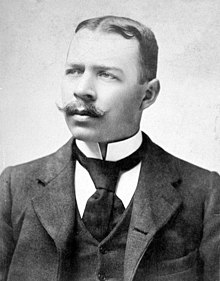
Carsten Egeberg Borchgrevink (1 December 1864 – 21 April 1934) was a Norwegian polar explorer and a pioneer of Antarctic travel. He inspired Sir Robert Falcon Scott, Sir Ernest Shackleton, Roald Amundsen, and others associated with the Heroic Age of Antarctic Exploration.
Borchgrevink was born and raised in Christiania (now Oslo) as the son of a Norwegian lawyer and an English-born immigrant mother. He began his exploring career in 1894 by joining a Norwegian whaling expedition, during which he became one of the first people to set foot on the Antarctic mainland. This achievement helped him to obtain backing for his Southern Cross expedition, which became the first to overwinter on the Antarctic mainland, and the first to visit the Great Ice Barrier since the expedition of Sir James Clark Ross nearly sixty years earlier. (Full article...) -

Vidkun Abraham Lauritz Jonssøn Quisling (/ˈkwɪzlɪŋ/; Norwegian: [ˈʋɪ̂dkʉn ˈkʋɪ̂slɪŋ] ⓘ; 18 July 1887 – 24 October 1945) was a Norwegian military officer, politician and Nazi collaborator who headed the government of Norway during the country's occupation by Nazi Germany during World War II.
He first came to international prominence as a close collaborator of the explorer Fridtjof Nansen, and through organising humanitarian relief during the Russian famine of 1921 in Povolzhye. He was posted as a Norwegian diplomat to the Soviet Union and for some time also managed British diplomatic affairs there. He returned to Norway in 1929 and served as minister of defence in the agrarian governments of Peder Kolstad (1931–32) and Jens Hundseid (1932–33). (Full article...) -

The black-throated loon (Gavia arctica), also known as the Arctic loon and the black-throated diver, is a migratory aquatic bird found in the northern hemisphere, primarily breeding in freshwater lakes in northern Europe and Asia. It winters along sheltered, ice-free coasts of the north-east Atlantic Ocean and the eastern and western Pacific Ocean. This loon was first described by Carl Linnaeus in 1758 and has two subspecies. It was previously considered to be the same species as the Pacific loon, of which it is traditionally considered to be a sister species, although this is debated. In a study that used mitochondrial and nuclear intron DNA, the black-throated loon was found to be sister to a clade consisting of the Pacific loon and two sister species, the common loon and the yellow-billed loon.
The black-throated loon measures about 70 cm (28 in) in length and can weigh anywhere from 1.3 to 3.4 kilograms (2.9 to 7.5 lb). In breeding plumage, the adult of the nominate subspecies has mostly black upperparts, with the exception of some of the mantle and scapulars, which have white squares. The head and hindneck are grey, and the sides white and striped black. Most of the throat is also black, giving this bird the name "black-throated loon". The colour of the throat patch can be used to distinguish the two subspecies; the throat patch of the other subspecies, G. a. viridigularis, is green. The underparts are mostly white, including the bottom of the throat. The flanks are also white, a feature which can be used to separate this bird from the Pacific loon. When the bird is not breeding, the black patch on the throat is absent, replaced with white; most of the black lines on the throat are also missing, except those on the bottom sides, and the upperparts are unpatterned with the exception of a few white spots on the upperwing. The juvenile is similar to the non-breeding adult, except more brown overall. (Full article...)
Selected article –
Selected picture –
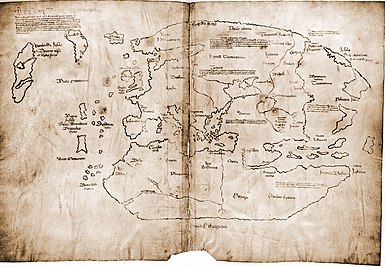
In this month
- Ole Borneman Bull (5 February 1810 – 17 August 1880) (pictured) was a Norwegian violinist, often called Norway's first international star.
- Alexander Lange Kielland (18 February 1849 – 6 April 1906) was one of the most famous Norwegian authors of the 19th century.
- Harald V (born 21 February 1937) is the King of Norway. He succeeded to the throne of Norway upon the death of his father Olav V on 17 January 1991.
General images –
-
The Kingdom of Norway about 1265, at its greatest extent (from History of Norway)
-
Smørbrød, Norwegian open sandwiches (from Culture of Norway)
-
Edvard Munch's The Scream (1893) (from Culture of Norway)
-
Map of Sweden–Norway (from History of Norway)
-
Norwegian Hardanger fiddle (from Culture of Norway)
-
Scenes from the Norwegian Campaign in 1940 (from History of Norway)
-
Petty kingdoms of Norway c. 872 (from History of Norway)
-
Bridal Journey in Hardanger (1848) by Adolph Tidemand and Hans Gude, an example of romantic nationalism (from History of Norway)
-
Industry along Akerselva in Oslo in 1912 (from History of Norway)
-
Homann's map of the Scandinavian Peninsula and Fennoscandia with their surrounding territories: northern Germany, northern Poland, the Baltic region, Livonia, Belarus, and parts of Northwest Russia. Johann Baptist Homann (1664–1724) was a German geographer and cartographer; map dated around 1730. (from History of Norway)
-
The Constituent Assembly which approved the Constitution of Norway (from History of Norway)
-
Røros, a major copper mining town, in 1869 (from History of Norway)
-
Statfjord oil platform (from History of Norway)
-
Bryggen in Bergen, once the centre of trade in Norway under the Hanseatic League trade network, now preserved as a World Heritage Site (from History of Norway)
-
Battle of Alvøen between the frigate HMS Tartar and Norwegian gunboats near Bergen in 1808 (from History of Norway)
-
Norwegian Prime Minister Kjell Magne Bondevik met with U.S. President George W. Bush at the Oval Office in White House, on 27 May 2003. (from History of Norway)
-
Roald Amundsen, Helmer Hanssen, Sverre Hassel and Oscar Wisting (l–r) at Polheim, the tent erected at the South Pole on 16 December 1911 as the first expedition (from History of Norway)
-
The Kalmar Union, c. 1400 (from History of Norway)
-
Traditional Norwegian St. Hansbål (midsummer) bonfire in Laksevåg, Bergen Municipality (from Culture of Norway)
-
Henrik Ibsen, c. 1890 (from Culture of Norway)
-
Map of Denmark–Norway (from History of Norway)
-
Trondheim in 1965 (from History of Norway)
-

Østhorn (until 1939 Korsvoll) is a station on the Sognsvann Line (line 5) of the Oslo Metro in Norway. It is located 7.1 kilometres (4.4 mi) from Stortinget station between Tåsen and Holstein stations. As one of the original stations on the line, Østhorn was opened on 10 October 1934. Nordberg was formerly the next northbound station, but it was closed in 1992, when the Sognsvann Line was upgraded to metro standard (power supply via third rail). Østhorn is located near a hill named Havnabakken, where local residents toboggan during winter time. (Full article...) -
Guttorm Sigurdsson (Old Norse: Guttormr Sigurðarson; 1199 – 11 August 1204) was the king of Norway from January to August 1204, during the Norwegian civil war era. As a grandson of King Sverre, he was proclaimed king by the Birkebeiner faction when he was just four years old. Although obviously not in control of the events surrounding him, Guttorm's accession to the throne under the effective regency of Haakon the Crazy led to renewed conflict between the Birkebeiner and the Bagler factions, the latter supported militarily by Valdemar II of Denmark.
Guttorm's reign ended abruptly when the child king suddenly became ill and died. Rumours among the Birkebeiner held that Guttorm's illness and death had been caused by Haakon the Crazy's future wife Christina Nilsdatter, a claim considered dubious by modern historians. Low-intensity civil war followed Guttorm's death, until a settlement was reached in 1207, temporarily dividing the kingdom. (Full article...) -
Bernt Michael Holmboe (23 March 1795 – 28 March 1850) was a Norwegian mathematician. He was home-tutored from an early age, and was not enrolled in school until 1810. Following a short period at the Royal Frederick University, which included a stint as assistant to Christopher Hansteen, Holmboe was hired as a mathematics teacher at the Christiania Cathedral School in 1818, where he met the future renowned mathematician Niels Henrik Abel. Holmboe's lasting impact on mathematics worldwide has been said to be his tutoring of Abel, both in school and privately. The two became friends and remained so until Abel's early death. Holmboe moved to the Royal Frederick University in 1826, where he worked until his own death in 1850.
Holmboe's significant impact on mathematics in the fledgling Norway was his textbook in two volumes for secondary schools. It was widely used, but faced competition from Christopher Hansteen's alternative offering, sparking what may have been Norway's first debate about school textbooks. (Full article...) -
The Ålgård Line (Norwegian: Ålgårdbanen) is a closed, but not abandoned, railway line between Ganddal and Ålgård in Rogaland, Norway. The 12.24-kilometer (7.61 mi) line was built as a narrow gauge branch line of the Jæren Line by the Norwegian State Railways (NSB) and opened in 1924. It runs through the villages of Foss-Eikeland and Figgjo in Sandnes to Ålgård in Gjesdal. Several proposals were made for the Ålgård Line to become the first part of the main line from Stavanger to Oslo, but instead the Sørlandet Line was connected to the Jæren Line in 1944. At the same time, the Ålgård Line was upgraded to standard gauge.
The line had up to ten daily round trips with diesel multiple units, until passenger traffic was terminated in 1955. Freight traffic remained until 1988, when most of the line was abandoned in 1988, although 3 kilometers (2 mi) was used until 2001. The line is owned by the Norwegian National Rail Administration. The station at Figgjo has been converted to a museum, and the 3-kilometer (2 mi) section from there to Ålgård is used for recreational draisines. There have been proposals to reopen the line either as part of the Jæren Commuter Rail or the planned light rail for Greater Stavanger. (Full article...) -
Øvre Pasvik National Park (Norwegian: Øvre Pasvik nasjonalpark, Northern Sami: Báhčaveaji álbmotmeahcci, Skolt Sami: Paččjooǥǥ meermeäʹcc) is located in the southeastern part of the Pasvikdalen valley in southern Sør-Varanger Municipality in Finnmark county, Norway. Covering an area of 119 square kilometers (46 sq mi), the national park is dominated by Siberian-like taiga consisting of old-growth forests of Scots pine, shallow lakes and bog. Proposals for a national park in Øvre Pasvik were first launched in 1936, but the park was not created until 6 February 1970. It originally covered 66 square kilometers (25 sq mi), but was expanded on 29 August 2003. Øvre Pasvik is part of Pasvik–Inari Trilateral Park along with the adjacent Øvre Pasvik Landscape Protection Area, the joint Norwegian and Russian Pasvik Nature Reserve, and Finland's Vätsäri Wilderness Area.
The park has its western border running along the Finland–Norway border. The two most prominent lakes are Ellenvatnet and Ødevatnet, both of which flow into tributaries of the river Pasvikelva. The fauna and flora are typical of the Siberian taiga, and include some species uncommon for Norway. The park is a habitat for the brown bear and also has a large population of moose; reindeer husbandry takes place during winter. Eight species of fish live in the lakes and the park has 190 species of flowering plants. (Full article...) -

The Jæren Commuter Rail (Norwegian: Jærbanen) is a commuter train service operated along the westernmost part of the Sørland Line in Jæren, Norway. It is operated by Go-Ahead Norge with nine Class 72 electric multiple units. The service acts as a commuter rail connecting Stavanger to its suburbs, including Sandnes, and to towns further south, in Klepp, Time, Hå and Eigersund. Although passenger services have operated along the lines since 1878, the commuter train service was inaugurated in 1992 with a significant increase of service, using existing rolling stock. Ridership of the system increased from 3.2 million in 2012 to 5 million in 2019.
The service runs from Stavanger Station to Egersund Station, a distance of 75 kilometers (47 mi). It has four hourly services from Stavanger to Sandnes Station, of which two continue to Nærbø Station and one to Egersund. The section from Stavanger to Sandnes is double track, while the rest is single track. The infrastructure is owned by the Norwegian National Rail Administration and the line is also used by intercity and freight trains. Several proposed upgrades to the system have been made, such as a branch along the Ålgård Line, a branch to Stavanger Airport, Sola and reestablishing double track from Sandnes to Egersund. (Full article...) -

Forskningsparken is a rapid transit station on the Sognsvann Line of the Oslo Metro. It also serves as a light rail station for the Ullevål Hageby Line of the Oslo Tramway. It is located at the north of the Blindern campus of the University of Oslo in the Nordre Aker borough of Oslo, Norway. The decision to build the station was made in 1998, and it opened in 1999, replacing the former station Vestgrensa, and allowed interchange between the metro and the tramway. The Ullevål Hageby Line was at the same time extended to serve the new Rikshospitalet. Forskningsparken is served by lines 4 and 5 of the metro, each operating every 15 minutes and providing services along both the Sognsvann Line and the Ring Line. Lines 17 and 18 of the tramway serve Forskningsparken, operating to Rikshospitalet and the city center. (Full article...) -

Stord Bridge with Stord in the background
The Triangle Link (Norwegian: Trekantsambandet) is a fixed link with three branches connecting the islands of Stord and Bømlo to each other and the mainland at Sveio, Norway. It consists of the underwater Bømlafjord Tunnel from Sveio to the island of Føyno, the Stord Bridge from there to Stord, and a road including the Bømla Bridge and the Spissøy Bridge to Bømlo. The section from Sveio to Stord is part of European Route E39, while the branch to Bømlo is part of County Road 542.
The Bømlo Tunnel is 7,860 meters (25,790 ft) long and reaches 260 meters (850 ft) below mean sea level. It is the longest subsea tunnel in Norway and was the deepest in the world when it opened. The Stord Bridge and Bømla Bridge are both suspension bridges, with lengths of 1,077 and 998 meters (3,533 and 3,274 ft) and main spans of 677 and 577 meters (2,221 and 1,893 ft). The Spissøy Bridge is a 283-meter (928 ft) beam bridge. The link is 21.5-kilometer (13.4 mi) long toll road with a toll plaza on Føyno. The section from Stord to Bømlo has a pedestrian and bicycle path. (Full article...) -

Oslo Commuter Rail (Norwegian: Lokaltog Østlandet) is a commuter rail centered in Oslo, Norway, connecting the capital to six counties in Eastern Norway. The system is operated by Vy (formerly NSB) and its subsidiary Vy Gjøvikbanen, using Class 69 and Class 72 electric multiple units (EMU). The network spans eight routes and 128 stations, with Oslo Central Station (Oslo S) as the central hub. The trains run on 553 kilometers (344 mi) of electrified mainline railway owned by the Bane NOR. Deficits are financed by the Norwegian Ministry of Transport, although the network also has a ticketing cooperation with Ruter, the public transport authority in Oslo and Akershus. The network is the longest commuter rail network in the Nordic countries, and among top ten in Europe.
The commuter rail operates mainly within Greater Oslo and two of the lines only provide services within the urban area. Six of the lines span beyond the urban area, reaching the counties of Østfold, Hedmark, Oppland and Buskerud. The system is also an airport rail link to Oslo Airport, Gardermoen. West of Oslo, the system uses the Drammen, Asker, Spikkestad and Sørland lines, north of Oslo it uses the Gjøvik Line, east of Oslo it uses the Trunk, Gardermoen and Kongsvinger lines and south of Oslo it follows the Østfold and Eastern Østfold lines. (Full article...) -

Håkons Hall, sometimes anglicized as Håkon Hall and Haakons Hall, is an arena located at Stampesletta in Lillehammer, Norway. With a spectator capacity of 11,500 people, it is the largest handball and ice hockey venue in the country. Håkons Hall is regularly used for handball and ice hockey tournaments, concerts, exhibitions, conferences and banquets. The venue is owned by Lillehammer Municipality via the subsidiary Lillehammer Olympiapark, which owns all the Olympic venues in Lillehammer. The Norwegian Olympic Museum is located in the arena, which is located next to the smaller Eidsiva Arena.
The hall opened on 1 February 1993, having cost 238 million Norwegian krone (NOK). It was built to host the ice hockey tournament at the 1994 Winter Olympics, and has since hosted the opening and closing ceremonies of the 1994 Winter Paralympics, the 1999 IIHF World Championship in ice hockey, the World Women's Handball Championship in 1993 and 1999, the Junior Eurovision Song Contest 2004, the 2008 European Men's Handball Championship and the 2010 European Women's Handball Championship. Lillehammer IK has occasionally played ice hockey matches at the arena. (Full article...) -
Stargate is a Norwegian record production and songwriting duo, composed of Tor E. Hermansen (born 14 October 1972) and Mikkel S. Eriksen (born 10 December 1972) and based in Los Angeles, California. The duo has been credited on hit songs and albums for American R&B, pop and hip hop acts.
Formed in 1996 in Trondheim, Norway, Stargate broke into the US recording industry in 2001, with their first major credit on the single "One Night Stand" by British girl group Mis-Teeq, which peaked within the top five of the Billboard Dance Charts. Stargate and Mis-Teeq saw further US chart success with the release of "Scandalous", which peaked at number two on the chart, as well as within the top 40 of the Billboard Hot 100. (Full article...) -
HMS Glatton and her sister ship Gorgon were originally built as coastal defence ships for the Royal Norwegian Navy, as Bjørgvin and Nidaros respectively. She was requisitioned from Norway at the beginning of World War I, but was not completed until 1918 although she had been launched over three years earlier. On 16 September 1918, before she had even gone into action, she suffered a large fire in one of her 6-inch magazines, and had to be scuttled to prevent an explosion of her main magazines that would have devastated Dover. Her wreck was partially salvaged in 1926, and moved into a position in the northeastern end of the harbour where it would not obstruct traffic. It was subsequently buried by landfill underneath the current car ferry terminal. (Full article...) -
The Røa Line (Norwegian: Røabanen) is a rapid transit line of the Oslo Metro, Norway, which runs from Majorstuen in Oslo to Østerås in Bærum. It serves neighborhoods such as Smestad, Hovseter, Huseby and Røa in northwestern Oslo, and Grini, Øvrevoll and Østerås in northeastern Bærum. The line is served by Line 2 of the metro, which connects to the city center via the Common Tunnel and onwards along the Furuset Line. The lowest part of the Røa Line, consisting of two stations, is shared with the Kolsås Line, and thus also served by Line 2 of the metro. The Røa Line is owned by Kollektivtransportproduksjon, and operated by Oslo T-banedrift on contract with the public transport agency Ruter.
The first part of the line, originally a light rail, was from Majorstuen to Smestad, and opened in 1912. It was built as a cooperation between the Municipality of Aker and the company Holmenkolbanen, and connected to the Holmenkoll Line's terminus. In 1928, the line received a connection to the city center when the first part of the Common Tunnel was completed. In 1935, the first extension of the Røa Line proper was made, when the line was extended to Røa. In 1942, the Kolsås Line became a branch. Additional extensions to the Røa Line were made in 1948 to Grini, in 1951 to Lijordet and in 1972 to Østerås. By then, the line had become an integrated part of the municipal Oslo Sporveier. The line was upgraded to rapid transit in 1995, became part of the metro and started running through the city center. (Full article...) -
Braathens SAFE Flight 139 was an aircraft hijacking that occurred in Norway on 21 June 1985. The incident took place on a Boeing 737-205 belonging to Braathens SAFE that was on a scheduled domestic flight from Trondheim Airport, Værnes to Oslo Airport, Fornebu. The hijacker was Stein Arvid Huseby, who was drunk during most of the incident. It was the first plane hijacking to take place in Norway; there were no deaths and no injuries. Huseby was sentenced to three years' imprisonment and five years' detention.
Armed with an air gun, Huseby threatened a cabin attendant and told the captain to proceed as planned to Fornebu. He claimed (falsely) to have placed explosives on board. His demands were to make a political statement and talk to Prime Minister Kåre Willoch and Minister of Justice Mona Røkke. The plane landed at 15:30 at Fornebu and was surrounded by the police. After one hour, Huseby released 70 hostages in exchange for having the aircraft moved closer to the terminal building. Thirty minutes later, Huseby released the remaining passengers. He drank throughout the incident, and at 17:30, after he consumed the plane's beer supply, he surrendered his weapon in exchange for more beer. The plane was immediately stormed and Huseby arrested. (Full article...) -

The Flåm Line (Norwegian: Flåmsbana) is a 20.2-kilometer (12.6 mi) long railway line between Myrdal and Flåm in Aurland Municipality, in Vestland county, Norway. A branch line of the Bergen Line, it runs through the valley of Flåmsdalen and connects the mainline with Sognefjord. The line's elevation difference is 866 meters (2,841 ft); it has ten stations, twenty tunnels and one bridge. The maximum gradient is 5.5 percent (1:18). Because of its steep gradient and picturesque nature, the Flåm Line is now almost exclusively a tourist service and has become the third-most visited tourist attraction in Norway.
Construction of the line started in 1924, with the line opening in 1940. It allowed the district of Sogn access to Bergen and Oslo via the Bergen Line. Electric traction was taken into use in 1944; at first El 9 locomotives were used, and from 1982 El 11. Until 1991, the train connected with a ferry service from Flåm to Gudvangen. In 1992, freight services were terminated, and due to low ticket prices and high operating costs, the line was nearly closed. In 1998, Flåm Utvikling took over marketing and ticket sale for the line, prices were heavily increased and El 17 locomotives were introduced (replaced by El 18 in 2014). The trains remain operated by the Vy as a subcontractor for Flåm Utvikling, while the line itself is owned and operated by the Bane NOR. (Full article...) -
Gjøvik Olympic Cavern Hall (Norwegian: Gjøvik Olympiske Fjellhall or Fjellhallen) is an ice hockey rink located within a mountain hall in Gjøvik, Norway. With a capacity for 5,500 spectators, the hall also features a 25-meter swimming pool and telecommunications installations. Opened in 1993 and costing 134.6 million Norwegian krone (NOK), it was built for the 1994 Winter Olympics, where it hosted 16 ice hockey matches. It is the home of Gjøvik Hockey, has hosted the 1995 World Short Track Speed Skating Championships and is also used as an event venue. The structure is the world's largest cavern hall for public use. (Full article...) -
Flekkefjord Station (Norwegian: Flekkefjord stasjon) is a former railway station located in the town of Flekkefjord in the municipality of Flekkefjord in Vest-Agder county, Norway. It served as the terminus of the 1,067 mm (3 ft 6 in) gauge Flekkefjord Line from 1904 to 1990. The station building was designed by Paul Armin Due and was built in brick Art Nouveau.
The station was important for transport along the coast until 1944, when the completion of the Sørland Line made Flekkefjord a branch station. At the same time, the line was converted to standard gauge, the number of station tracks was reduced, and the station received an overhaul. The station building was demolished in 1970, but the station was still served until the line closed in 1990. The tracks and depot buildings still exist. (Full article...) -
Olav Meisdalshagen (17 March 1903 – 21 November 1959) was a Norwegian politician for the Labour Party best known for serving as the Norwegian Minister of Finance from December 1947 to November 1951 and as the Norwegian Minister of Agriculture from January 1955 to May 1956. He was also a Member of Parliament for a long time, being elected for the first time in parliamentary election of 1936 and serving until his death, except for the period between 1940 and 1945 when the Parliament of Norway was de facto defunct due to the occupation of Norway by Nazi Germany. His death in 1959 came halfway through his fifth term in Parliament, and shortly after a parliamentary speech.
A jurist by profession, Meisdalshagen came from a humble family background, growing up at a former crofter's farm in rural Nord-Aurdal, and losing his father in the 1920s. After studying he moved back to Nord-Aurdal, worked as an attorney and built the Labour Party organization in the region. The background formed him in that his main political goal was to improve the economy of dwellers in rural farming districts. He was a proponent of economic regulation, which marked his period as Minister of Finance. However, his period was also marked by the dominance of Erik Brofoss and the Ministry of Trade in deciding the country's overall financial policy. When Trygve Bratteli succeeded Meisdalshagen as Minister of Finance, the ministry regained its dominance, but also set out on a gradual deregulation. This, in addition to Meisdalshagen's discontent with increased spendings on defence, made him an oppositional figure within the Labour Party. He did return briefly to cabinet as Minister of Agriculture, and also cooperated with the government through the position as chairman of Norges Kooperative Landsforening, a national association of consumer co-operatives. However his oppositional tendencies grew stronger in his later life. He was a part of the "Easter Uprising" in 1958, and in 1958 and 1959 there were rumours of Meisdalshagen worked behind the scene to facilitate a change of personnel—and policy—in the Labour Party. His death came in this period. (Full article...) -
Oslo Airport Station (Norwegian: Oslo lufthavn stasjon), also known as Gardermoen Station, is a railway station located in the airport terminal building of Oslo Airport, Gardermoen in Norway. Located on the Gardermoen Line, it is served by the Airport Express Trains, express trains to Trondheim and Oslo, regional trains to Lillehammer and Skien (via Oslo) and commuter trains to Eidsvoll and Kongsberg (via Oslo).
The station is located 48 kilometres (30 mi) from Oslo Central Station. The station is staffed, and there is a single bus route, and several coach services, to and from the airport. It opened in 1998, along with the new airport. During 2000–2001, there were several derailments at the station. South of the station is a terminal for unloading freight trains carrying aviation fuel. (Full article...) -
Troll is a Norwegian research station located at Jutulsessen, 235 kilometres (146 mi) from the coast in the eastern part of Princess Martha Coast in Queen Maud Land, Antarctica. It is Norway's only all-year research station in Antarctica, and is supplemented by the summer-only station Tor. Troll is operated by the Norwegian Polar Institute and also features facilities for the Norwegian Meteorological Institute and the Norwegian Institute for Air Research.
Unlike most other research stations on the continent, Troll is constructed on the snow-free slope of solid rock breaking through the ice sheet at Jutulsessen, located 1,275 metres (4,183 ft) above mean sea level. The station opened as a summer-only station in 1990 and was taken into use as an all-year station in 2005. It has an overwintering capacity of six people and a summer capacity of 70. It is served by Troll Airfield, which is the base for the Dronning Maud Land Air Network (DROMLAN). (Full article...) -
The Svalbard Rocket Range or SvalRak as it is named, is a launch site for sounding rockets at Ny-Ålesund in Svalbard, Norway. The site has been in use since 1997 and is owned by Andøya Space Center, which is owned by the Norwegian Ministry of Trade, Industry and Fisheries and the Kongsberg Group. SvalRak's location at the 79th parallel north makes it well-suited for launching rockets to investigate Earth's magnetic field. It is used mostly by American, Japanese and Norwegian researchers. It is the world's northernmost launch site. (Full article...) -
The Romerike Tunnel (Norwegian: Romeriksporten) is a 14.580-kilometre (9.060 mi) railway tunnel in Norway between Oslo and Lillestrøm. It is the second longest railway tunnel in Norway after the Blix Tunnel opened in 2022, and forms the first section of the Gardermoen Line. It is double track and electrified, permitting speeds of 210 kilometres per hour (130 mph).
Construction started in 1994, with plans to open with the rest of the Gardermoen Line and Oslo Airport, Gardermoen on 8 October 1998. Due to serious leakage from Lutvann and several other lakes, it did not open until 22 August 1999. The leaks increased the cost of the tunnel from 0.5 billion kr to NOK 1.8 billion. The main contractor was Scandinavian Rock Group. The tunnel was originally owned by NSB Gardermobanen, then the Norwegian National Rail Administration, and now owned by Bane NOR. The tunnel allows long-distance, regional and Flytoget Airport Express Trains to bypass the old Hoved Line, reducing journey times between Oslo and Lillestrøm from 29 to 12 minutes. (Full article...) -
Jørgine Anna Sverdrup "Gina" Krog (20 June 1847 – 14 April 1916) was a Norwegian suffragist, teacher, liberal politician, writer and editor, and a major figure in liberal feminism in Scandinavia.
She played a central role in the Norwegian liberal women's rights movement from the 1880s until her death, notably as a leading campaigner for women's right to vote. In 1884, Krog co-founded the Norwegian Association for Women's Rights with liberal MP Hagbart Berner. Over the next two decades, Krog co-founded the Women's Voting Association, the National Association for Women's Suffrage, and the Norwegian National Women's Council, spearheading the presentation of women's suffrage proposals to the Storting (the Norwegian parliament). Krog wrote articles and gave speeches, travelling throughout Europe and North America to attend international women's rights conferences. She was editor of the Norwegian feminist periodical Nylænde (New Land) from 1887 until her death in 1916. She was an early member of the Liberal Party and served as a deputy member of its national board. Krog was strongly inspired by the American liberal women's rights movement spearheaded by Susan B. Anthony and Elizabeth Cady Stanton. (Full article...) -
Anniemal is the debut album by Norwegian singer Annie. It was first released by 679 Recordings in September 2004. Annie began recording music in 1999 with her boyfriend, Tore Kroknes, who died in 2001. She returned to recording later that year, collaborating with Richard X, Röyksopp, and Timo Kaukolampi.
The album combines Annie's thin, airy vocals with heavily layered beats. It is heavily influenced by 1980s dance-pop. Upon release, the album was successful in Norway. Blogs leaked tracks from Anniemal before it was released internationally, and publications from other countries soon praised the album for its blissful but melancholic sound. (Full article...) -
The Bjorøy Tunnel (Norwegian: Bjorøytunnelen) is a 2,012-metre-long (6,601 ft) subsea road tunnel in Vestland county, Norway. The tunnel is part of the Norwegian County Road 5236 which connects the island of Bjorøy in the municipality of Øygarden to the mainland near Håkonshella and Hilleren in the city-municipality of Bergen. It crosses underneath the Vatlestraumen strait, reaching 88 metres (289 ft) below mean sea level. It serves as a fixed link for the 900 residents of the islands of Bjorøy and Tyssøy as well as a large number of cottage owners who vacation on the islands. The first proposal was launched in 1980, and construction started on 29 September 1993. There were severe problems because the tunneling encountered an area of sandstone, causing a year's delay. The total construction cost was 59 million kr. It opened on 7 May 1996 and remained a toll road until 29 January 2005. (Full article...)
Selected biography –
Did you know –
- ...that in 1902, the Church of Norway priest Jens Jonas Jansen was called "dangerous" by bishop Johan Christian Heuch (pictured)?
- ...that the history of the Oslo Tramway started with the construction of a horsecar line to Homansbyen in 1875?
- ...that Torolf Elster, former Director-General of the Norwegian Broadcasting Corporation (NRK), was also an awarded crime writer?
Selected quote –
Categories
Selected panorama
Bergen is the second-largest city in Norway, a municipality, and a former county, in the county of Hordaland. The city is located on the south-western coast of Norway, in the county of Hordaland, with its centre situated between a group of mountains known collectively as de syv fjell ("the seven mountains"), although the number of mountains is a matter of definition. (Full article...)
Main topics
Counties: • Agder • Innlandet • Møre og Romsdal • Nordland • Oslo • Rogaland • Troms og Finnmark • Trøndelag • Vestfold og Telemark • Vestland • Viken (county)
Culture: Bunad
• Constitution Day
• Cuisine
• Farm culture
• Jul
• Literature
• Music
• Cinema
History: Ancient Norwegian property laws • Nordic Stone Age • Nordic Bronze Age • Komsa • Fosna-Hensbacka culture • Funnelbeaker culture • Hamburg culture • Nøstvet and Lihult cultures • Maglemosian culture • Viking Age • Harald I of Norway • Olav IV of Norway • Haakon I of Norway • Olaf I of Norway • Olaf II of Norway • Battle of Stiklestad • Canute the Great • Magnus I of Norway • Harald III of Norway • Battle of Stamford Bridge • Magnus III of Norway • Sigurd I of Norway • Magnus V of Norway • Sverre of Norway • Haakon IV of Norway • Magnus VI of Norway • Eric II of Norway • Kalmar Union • Denmark–Norway • Union between Sweden and Norway • Dissolution of the union between Norway and Sweden in 1905 • Haakon VII of Norway • Olav V of Norway • Harald V of Norway • Occupation of Norway by Nazi Germany • Norwegian Campaign • Norwegian resistance movement • Legal purge in Norway after World War II • Foreign relations of Norway • Military of Norway • Norway and the European Union
Language: Å • Æ • Ø • Bokmål • Det Norske Akademi for Sprog og Litteratur • Differences between Norwegian Bokmål and Standard Danish • Høgnorsk • Nordic Council • Nordic Language Convention • Noregs Mållag • Norsk Ordbok • North Germanic languages • Norwegian alphabet • Norwegian dialects • Norwegian Language Council • Norwegian language conflict • Norwegian phonology • Nynorsk • Old Norse • Riksmålsforbundet • Russenorsk
Politics: Constitution • Counties (Fylker) • Elections • European Union relations • Foreign relations • Government • Monarchy • Municipalities (Kommuner) • Political parties • Prime Minister • Norwegian nationalism • Romantic nationalism • Sámi Parliament • Storting
Featured and Good content
Related portals
Northern Europe
Other countries
WikiProjects
- Parent projects
WikiProject Countries • WikiProject Europe
- Main project
- Similar projects
WikiProject Denmark • WikiProject Finland • WikiProject Iceland • WikiProject Sweden • WikiProject Russia
What are WikiProjects?
Things you can do
- Add {{Portal|Norway}} to existing See also sections of Norway-related articles.
- Tag the talk pages of Norway-related articles with the {{WikiProject Norway}} banner.
- Rate the Unassessed Norway articles in the Norway WikiProject.
- Requested articles: Requested Norway-related articles
- Expand stubs: Building and structure stubs, Company stubs, Nordic football club stubs, Geography stubs, History stubs, Musical group stubs, People stubs, All Norway stub articles
- Note: For additional tasks, see - Wikipedia talk:WikiProject Norway/to do
Associated Wikimedia
The following Wikimedia Foundation sister projects provide more on this subject:
-
Commons
Free media repository -
Wikibooks
Free textbooks and manuals -
Wikidata
Free knowledge base -
Wikinews
Free-content news -
Wikiquote
Collection of quotations -
Wikisource
Free-content library -
Wikiversity
Free learning tools -
Wikivoyage
Free travel guide -
Wiktionary
Dictionary and thesaurus



